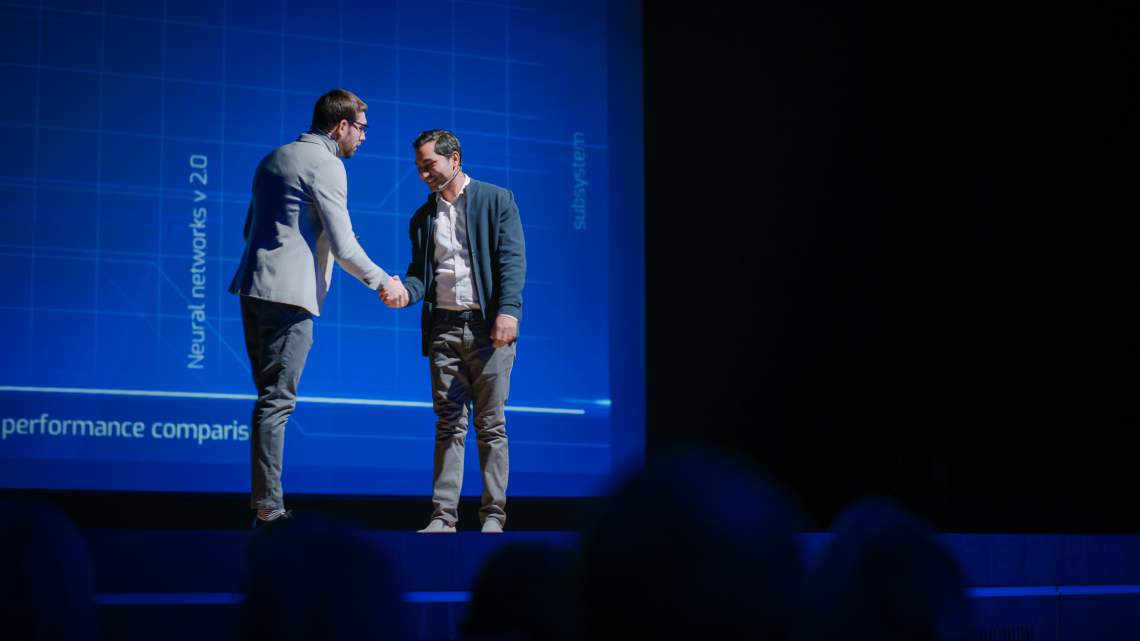
Because First Impressions Aren’t Everything: 20 Tips and Ideas to End Your Presentation in Style
“After a while I went out and left the hospital and went back to the hotel in the rain.”
If you are a big literature lover, you might recognize this sentence. If not, that’s okay too. In this article, however, we’re not talking about literary expertise but rather about a successful conclusion to a presentation.
How these two are related will be revealed in the final tip. However, you can truly benefit from it only if you have internalized the other tips as well.
Why the end of your presentation should be more than an afterthought
A great dessert is the perfect finish to a dinner. It has the power to elevate even the most mediocre of starters. A surprising, powerful ending to a film often stays with us longer than the rest of the story. Musicians close their concerts with something special to send their audiences off in high spirits. In a commercial, we always hear the key slogan at the end.
So why do so many presentations end with a terse, “Well, I guess that’s it. Thanks for your attention”, or some other lackluster phrase?
It could be due to that time-honored truth; most people just don’t like presenting. For many, it’s an annoying but necessary duty. For some, it’s an extremely unpleasant challenge. Add to that an audience that isn’t always filled with interested listeners and it’s no wonder most presenters rush through their conclusion.
Which is a shame. Because when you put a lot of effort into a presentation to convince and stand out, you deserve to end the presentation appropriately. Do justice to your efforts and don’t waste valuable points at the last moment! Attention is particularly high at the end, and what is said last remains in memory the longest. Of course, the focus of information is in the middle, but often it is not the information that makes the difference, but rather the emotion.
And at the end, you can trigger emotion effectively. A particularly compelling ending can even make the decisive difference. To assist you in creating such a presentation ending, we have listed 20 helpful tips for you below.
So here are 20 useful tips and tricks that will help you finish your presentation in style:

1. Have the courage to do it differently!
Look back on presentations you’ve sat through; you probably can’t remember much about their conclusions. There’s usually a slide thanking the audience for their attention and that’s it. Finding memorable, surprising, exciting or stirring ways to close a presentation is a challenge. But maybe that’s the key: Step out of your comfort zone and do it differently. Be creative. This is the best start for a memorable finish.
2. Continuity: Avoid a random ending to your presentation
Many speakers don’t spend a lot of time thinking about how to wrap up their presentations. As long as the content is there, the rest will follow. Remember, a non-committal, “So, I think that’s it from me” will be the last thing an audience remembers. And no one wants that kind of anticlimactic finish to a compelling presentation.
In short, it pays to spend time on your conclusion. Even the most eloquent and experienced presenters need to plan this last, decisive section of a presentation as carefully as the rest.
3. Put the cart before the horse: The goal remains the focus
This tip may sound a bit strange at first: When preparing presentations, it’s sometimes a good idea to take the last step first. Most people prepare their presentations like this: beginning, middle, end. It’s a logical approach but all too often, it leads to a conclusion that just fizzles out. So why not start there?
Ask yourself: Where am I going with this? Which core message should run through the entire presentation and be highlighted at the end? Once you’ve figured that out, you can start structuring the rest of your presentation.
Tip: In our blog, we have published a post that provides you with further valuable tips for the perfect preparation for your next presentation. You can directly access the blog post here.
4. Bookend your presentation
You think the beginning of your presentation has nothing to do with the end? Think again. One good way to bring your presentation full circle is to close the rhetorical circle and return to your key statement.
Bookending is the technique of starting and finishing a presentation with similar or related content. For example, you can start your presentation with a question, come back to it at the end of and answer it with your closing statement. This frames your presentation and brings your audience full circle.
5. Don’t announce the end
When a presentation is drawing to a close, an audience often hears, “As I slowly wrap things up,” or, “We’re almost at the end now.” or even, “You’re almost free of me now.” Phrases like these are used a lot, but are they really necessary? Truth is, they give the feeling that presenters and audience alike can’t wait for a presentation to be over. It sounds as if the presenter find his or her own presentation boring and way too long. It’s also an invitation for the audience to tune out, gather their things and plan the rest of their day.
But there are ways to announce the end without losing your audience. Phrases like, “Now for one final, key point.”, can help lead your audience and refocus their attention. But announcing the end of a presentation is, in general, not necessary. Your final summary or call to action is usually enough.
6. Compelling Storytelling: Building a Climactic Tension Curve
Just like a good book, your presentation needs a narrative arc that builds anticipation. Paint an exciting image of your company’s future or catch them by surprise with a contradictory or unexpected statement. Or build your presentation so that your strongest argument is at the end.
With this little trick, you can make sure that your key statement is the last impression you make on your audience. It’s a great way to refocus your audience and generate excitement.
Tip: There is already a separate post on our blog about storytelling as an approach for a more convincing presentation. You can find the post here.
7. To summarize or not
It depends! Not every presentation requires a traditional summary of what has been learned. Especially presentations that are structured using the storytelling method often have a different closing.
Skilled presenters allow their audience to experience an “aha” moment in their presentation by closing the rhetorical circle. For example, in this method, a guiding question that was raised at the beginning of the presentation could be answered at the end.
However, this is not the only way to structure a presentation. In particular, in speeches that explore many different aspects and bring together various lines of argumentation, a conclusion is still a popular tool.
A good conclusion summarizes all the important arguments and key points of your presentation and establishes the connections. At the end of your presentation, bring together all the information and highlight the bigger picture on a slide. This provides your audience with something concrete to remember as a conclusion.
8. Make it memorable

Just like advertising, effective presentations are often about anchoring something in people’s memory. The way to do this is through repetition. The more often we hear, experience or do something, the more likely we are to remember it for a long time.
The end of a presentation is a good time to repeat and emphasize important content. You can also try to introduce a few prompts that will help your audience remember your presentation later on. For instance, you could do this with a small suggestion: “When you’re on your way home, think back on my traffic lights metaphor.”
Or provide a helpful tip: “By the way, the little technique I just told you about can also help you with your kids.” This kind of connection to everyday life makes the presentation more interesting and relatable to the audience and helps keep the mood light.
Tip: Read here how to incorporate humour into your presentations in good doses.
9. Focus on the final phrase
The last sentence of a presentation is more significant than you might think. Even if some of your audience have mentally drifted off, they’re usually back at full attention by the end. So, make the most of this and pay close attention to your closing words.
Your final phrase should reflect your core message. Also, ask yourself what thought or feeling you want to leave your audience with.
Here are a few ideas to help you formulate your closing statement:
- Always align your final message to the rest of the presentation.
- Keep it short.
- Address your audience on an emotional level. Try to create positive feelings, powerful calls to action, make thoughtful or humorous comments.
- A slogan or a message that you already established as a core statement in the presentation can be brought back at the end.
- Using stylistic devices, such as alliterations, can be an effective way to get the message across.
- Frequent presenters can also create a closing statement that they use as a catchphrase for each presentation. TV presenters and news anchors do this often. (A well-known example: Walter Cronkite would close news broadcasts with, “And that’s the way it is,” followed by the date.)
- The final phrase doesn’t have to be yours. A quote from a well-known person can underline your statements wonderfully. Even a famous, perhaps slightly modified proverb can provide a meaningful and memorable close.
- The final sentence doesn’t even have to be a sentence. An image or perhaps a short video can also be an effective, atmospheric conclusion.
10. Create a feeling of community
We humans are social beings and feel comfortable when we form a harmonious community. Therefore, it is particularly appropriate to focus on creating harmony and unity at the end in order to evoke positive emotions.
Be mindful of not creating a barrier between yourself and the audience with your final words. This can be easily achieved by using inclusive language.
Instead of saying, “I conclude that…” or “You have now learned that…,” say “We can now see that…” or “It is clear to us now that…”. This creates a sense of unity and agreement, and reinforces the idea that you are on the same side as the audience.
11. Keep calm and carry on – right to the very end
It’s important to maintain poise and confidence throughout a presentation. That means the conclusion, too. Avoid the tendency to seek approval and don’t over-apologize for any fumbles you may have made. Mistakes and faux pas happen and when they do, simply acknowledge them, correct them and keep going. And whatever you do, don’t bring them up again at the end of your presentation. You audience will have already forgotten them and moved on. And so should you.
This sounds easier than it is, because negative phrases such as “Sorry I couldn’t explain topic xy in more detail” or “I hope I didn’t bore you too much” come really naturally to most of us. You’ll need to practice a little self-control to leave your inner critic where it belongs: inside.
12. End of presentation = end of topic
An end can also be a new beginning – but not in this case. Don’t end your presentation with a new idea. This can just confuse your audience and dilute your core message. If you remember something you forgot, leave it out or add it to any follow-up material you may send by email.
An exception to this tip is when the presentation is followed by a discussion or Q&A session. This is when new ideas can be brought up and explored.
13. Call your audience to action
Give your audience a clear and direct call to action at the end of your presentation. Now’s the time to plug your product, services, your new website or podcast. When done right, these “plugs” will sound less like self-promotion and more like a friendly offer: “If you’d like to learn more, feel free to check out my book.”
14. Transition smoothly to a discussion or Q&A session
Let your audience know at the beginning of your presentation whether questions can be asked during or saved for after. If you’re planning a Q&A session or discussion at the end of the presentation, make sure you create a smooth and confident transition.
Anyone who starts with a simple, “Are there any questions?” or even just a brief, “Questions?” can expect to be met with awkward silence. Get the conversation started by referencing a point you made in your presentation (“What are your thoughts on…”). This also allows you to steer the conversation and revisit some important points from the presentation.
15. The final slide
When all has been said, most presentations still have a slide that, in a way, announces the end. Sometimes it just says End, or Questions? or the infamous, Thank you for your attention in large letters. You can do it that way, but you can also do it better.
The last slide can be a picture, a meme or a comic, which can loosen things up and arouse emotions. You can also choose no concluding slide at all or a completely black slide. This can provide the space for a transition to the Q&A session or a discussion: “As you can see, I’ve reached the end of my presentation. Now it’s your turn.”.
Tip: If you want to speed things up, you can also use our “Closing Slides / Thank You Slides” templates for PowerPoint for your last slide. Click here to go directly to the product.
16. Thank you?
Do you thank the audience for their attention at the end of a presentation or not? Opinions differ a little on this. For many, it’s common practice and, well, simply good manners. For others, it’s a mundane, overused phrase that brings little value at the end of a presentation. So, what to do?
You can of course leave a final “thank you” out. No one will think less of your presentation if you do. But, if you’re like me and can’t imagine not thanking an audience for their time, forgo the thank you slide, use one of the other tips to give your presentation a strong finish, then say give a simple and sincere “thank you”.
17. Add a personal touch
Personal words create a sense of familiarity and communicate appreciation. A friendly farewell can help ensure you and your presentation won’t be quickly forgotten. A quick goodbye doesn’t cut it. Instead, try something like, “I hope you get home safe and sound in this weather.”
You can also connect your personal message to your presentation topic: “I hope you enjoy implementing my method as much as I did. Send me an email to let me know how it goes.” Of course, your content should score points, but don’t underestimate the power of likeability.
18. Take your time
It’s natural to feel relieved after a successful presentation. Unfortunately, this often leads to speakers fleeing the scene. No sooner have the last words been spoken, than the laptop is shut down, the projector switched off and the presenter is dashing out the door before the applause has ended. Nobody gains from this. The presenters doesn’t allow him or herself to enjoy audience recognition and the audience has the feeling that the presenter has lost interest and just wants to go home.
Take your time. Enjoy the applause, maintain eye contact with the audience, acknowledge them and smile. There will be time to pack up later.
By the way: Also pay attention to the speed of your speech. Many presenters, without realizing it, tend to speak more quickly as they approach the end of a presentation.
19. Manage your time
Anyone else remember that awkward moment at the end of almost every university lecture? The professor is still talking, yet the majority of fellow students are already loudly packing up and leaving the room. Pretty rude behavior. However, there may be a valid excuse for it.
Students have other classes to get to, papers to write and exams to study for. In other words, their time is precious. Among your audience will often be clients, managers and colleagues who have back-to-back meetings that day. For them, time is truly of the essence; they’ve planned their day to the last minute.
This same kind of careful planning and thorough time management should be applied to your presentation. Timeboxing allocates a certain amount of time to an activity in advance to complete it within that time frame. Practice your presentation in advance with friends or relatives and time yourself. Allocate enough time for each part of your presentation and plan some buffer time so you don’t have to rush through your closing statement. Timeboxing your presentation will give it an easy, comfortable pace. Your audience will thank you for it.
20. No pain, no gain!
Let’s return to our quote from the beginning: “After a while I went out and left the hospital and went back to the hotel in the rain.” This is the last sentence from Ernest Hemingway’s novel, In Another Country. So, what does this have to do with a presentation or its conclusion for that matter? Actually, nothing at all. But Hemingway is said to have changed and rewritten this one last sentence 39 times before finally settling on it. He was obviously aware of the importance of a good ending and was willing to invest time and effort to make it unique and memorable. Be like Hemingway. It’s worth it!
If you need assistance with your presentation ending, don’t hesitate to reach out. We are a nationally and internationally successful PowerPoint agency with years of practical expertise in the business sector. We would be happy to help. Please contact us via email at [email protected].
On that note, thanks for reading. ;-)
These articles might be interesting for you:





